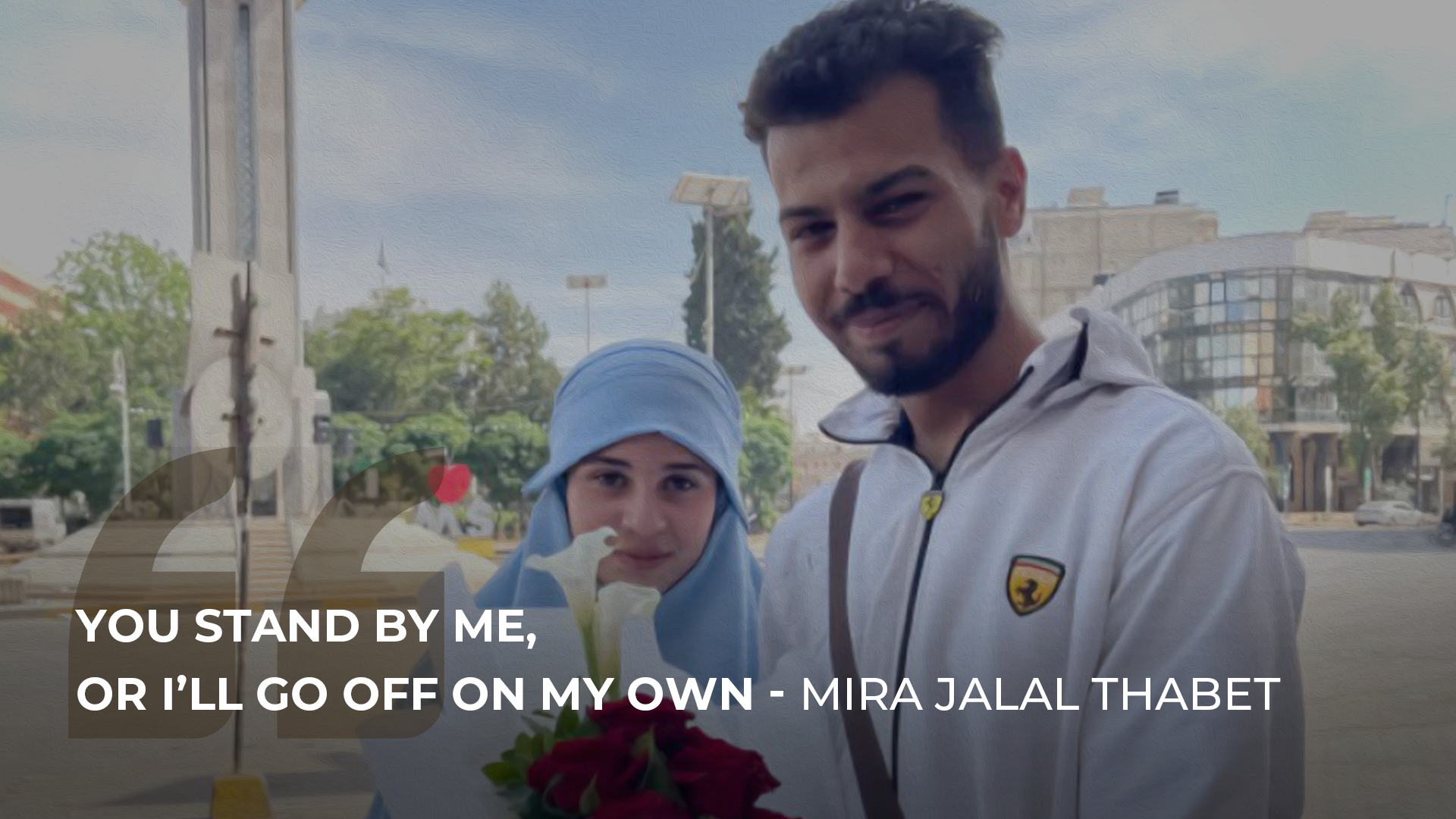
In the grainy footage first shared on social media, Mira Jalal Thabet stood beside her husband Ahmad, veiled in modest Islamic clothing, while looking into the camera. “There was no kidnapping,” she said firmly. “I was under pressure at my family’s house… and since there was love between me and Ahmad, I turned to him.” Her words were meant to clarify, but by then the rumors had taken hold.
What began as a young woman leaving home to marry the man she loved was swiftly spun into a narrative of abduction and captivity. Social media accounts accused Ahmad of forcibly taking Mira from her Alawite family in Talkalakh to Idlib. Echoes of ISIS atrocities—kidnapping, enslavement—were invoked without evidence. The story was shared widely, picked up by regime-linked propagandists, and presented as proof of chaos and extremism in Sunni-majority areas. But it was false.
Between Love and Lies
Mira and Ahmad’s story told in their own words during public interviews, is clear. “What happened was a lawful marriage, both religiously and legally,” Ahmad said. Mira confirmed, describing the emotional pressure she faced at home and the support she found in Ahmad. “I told him, ‘Either you stand by me, or I’ll go off on my own.’” She had already left her home when she contacted him.
The Arabic language, fact-checking platform Kashaf confirmed their account, tracing the rumors to social media speculation and family tensions rather than any criminal wrongdoing. Syrian refugee and author, Inas Awad, of Homs, pointed out that this was not a unique case. Mira, like many women before her, fled a restrictive environment for love—and was punished for it, not by law, but by the court of public opinion and the weight of sectarian taboo.
The Invisible Walls of Sect
Inter-sect and interfaith marriages in Syria have long been fraught with social and political risk—especially for women. While high-profile intermarriages among Syria’s elite, like that of former regime leader Bashar al-Assad (an Alawite) and Asma al-Assad (a Sunni), are spared public scrutiny, ordinary Syrians pay a steep price for crossing sectarian lines.
For Mira, being Alawite and marrying a Sunni man put her at the center of an age-old tension. According to Alawite author Ahmed Khalil, in an article for Open Democracy, despite religious teachings not forbidding such unions, the cultural resistance, writes, within many sectarian communities—especially among the Alawites and Druze—is strong. As one proverb still whispered in Syrian villages puts it: “He who marries from outside his sect dies of a sickness that is not his.”

Stories like Catherine Mizher’s, a Druze girl who eloped with an Alawite man in 2017 and was falsely declared kidnapped and murdered by her family, follow the same tragic arc. Catherine later appeared alive in videos, stating her case simply: her family rejected her marriage, and she ran away.
The stakes are high, especially for women. “Honor crimes” were once prosecuted with leniency under the defunct Assad regime—until recently, with maximum penalties of just two years. The legal system, built to leverage sectarian divides, reinforced these barriers. Even when such marriages occur, they are often hidden or conducted abroad, in another province or village outside the couple’s region, or in places like Lebanon or Cyprus.
How Misinformation Fuels Sectarianism
What happened to Mira didn’t occur in a vacuum. Her story was quickly weaponized as part of a broader disinformation campaign—one of many in Syria’s decade-long conflict, where rumors are used as political tools to deepen sectarian divides and smear the new government.
In the past, pro-Assad media outlets, and even more mainstream channels like Al-Hadath or Al-Monitor have promoted sensational, unverified claims about the revolutionaries: false reports of Sunni slave markets in Idlib, fabricated massacres of Christians, and baseless allegations of Alawite purges. Even Israel has reportedly played a role in stoking sectarian tension, particularly between Druze and Sunni communities, by spreading fear through carefully engineered propaganda.
The spread of Mira’s story follows this pattern. Inflammatory language, like claims of “enslavement” and “ISIS-style abduction,” was quickly amplified online. But these narratives often unravel under scrutiny, as did this one. The facts were less dramatic but more important: Mira exercised agency. She defied sectarian norms. And she paid for it not with imprisonment or violence, but with slander.
A Changing Social Landscape
Despite the rigidity of Syria’s sectarian traditions, stories like Mira and Ahmad’s also reveal signs of change. Displacement and war have disrupted the insular structure of many communities. Millions of Syrians have been forced to flee their homes, often ending up in areas where they live alongside members of other sects.
In former regime-held cities like Homs and Latakia, the new influx of previously displaced Sunnis has led to a quiet increase in inter-sect marriages. But these unions often remain unofficial, unregistered, and socially hidden. In previous revolutionary strongholds like Idlib, however, the demographic is almost entirely Sunni, due to the war, and intermarriage has all but disappeared. Judge Ibrahim Hussein explains that “each sectarian denomination… distanced itself from other denominations due to the conflict caused by war.”
Still, these freedoms are fragile. Civil marriages conducted outside Syria or the normal cultural enclaves are often not recognized by many Syrians, and children from such unions may face legal and social complications if they return to their areas. The state continues to strive to repair a society fractured by nearly 14 years of war and over half a century of state-sponsored sectarianism.
“We’re All Here—and Syria Is Fine”

Mira and Ahmad’s case is more than a personal love story; it is a reflection of Syria’s social fault lines—exposed, strained, and manipulated. In a country where the former regime claimed “secularism” while enshrining sectarian rules into law, in a fragile transitional landscape where rumor spreads faster than truth, and where marrying the “wrong person” can mean death or exile, their story matters.
In her interview, Mira and her husband appealed for dignity, not drama: “Here is Mira, here is Ahmad, and we’re all here—and Syria is fine.” But Syria is not fine—not for young people trapped by old customs, not for women whose choices are criminalized, and not for the truth, which too often gets buried beneath propaganda.
Yet stories like Mira’s, when told honestly, can cut through the noise. They remind us that behind every rumor is a person, behind every slur a story—and that sometimes love, even in Syria, can be revolutionary.








